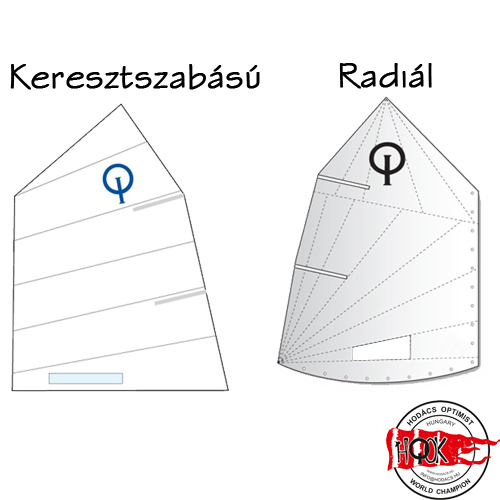Optimist sails
Hello everyone!
I’m continuing our last topic on equipment, this time focusing on sails instead of spars. (Thanks for all the positive feedback on the spars post!)
Like choosing the right spars, selecting the right sail can significantly support a sailor’s development. Together, the right sail and spars form a complex system that requires close attention to perform well.
Optimist Sail Specifications
The class rules dedicate an entire section (Section 6) to sails, covering rules on construction and materials. Sailmakers must adhere to these specifications due to the one-design nature of the Optimist class. Most rules address dimensions, batten pocket placement, reinforcement methods, and positions. Beyond this, sailmakers decide on other elements, like the sail's draft, entry profile, and batten stiffness, allowing for customization. This flexibility means a compliant sail can be designed for a sailor weighing under 30 kg as well as for a sailor over 50 kg.
Types of Sail Cuts
The panels that make up a sail can vary in size and shape to adjust where and how the sail’s draft is positioned. There are three main sail cuts:
- Crosscut: The sail panels run parallel to the boom.
- Radial cut: The sail panels radiate from the back corner and/or the upper corner.
- Mixed cut: Previously more available, but not as common today.
Each cut has its advantages:
- Crosscut sails: Tend to be less sensitive to handling errors, making them forgiving of minor imprecisions in sail handling.
- Radial cut sails: Require precise handling and greater concentration, which can suit more experienced sailors.
Key Considerations in Sail Selection
When choosing a sail, consider factors such as:
- Typical conditions at your training/racing location (e.g., strong vs. light winds, wave conditions).
- Sailor’s weight and whether they’re in a growth phase.
- Sailor’s sailing style (e.g., “grinding” vs. “free-flowing” technique).
- Sail handling habits—whether they make frequent and precise adjustments or only when prompted.
Trends and popularity can also influence sail choice. While certain brands are widely used, others outside the mainstream can also perform well, as evidenced by previous championships won with Windesign sails or the Dutch national team using Optimax sails (known primarily for spars).
Summary of Popular Sails and Recommendations
To simplify your choices, here’s a reference table with some popular sail options, recommended weights, and categories based on cut type.
|
One Sails |
Olimpic Sails |
J Sail |
|||
|
Type |
Recommended weight |
Type |
Recommended weight |
Type |
Recommended weight |
|
Light |
under 32kg |
Red |
under 38kg |
Green |
under 35kg |
|
Medium |
under 42kg |
Happy |
37-42kg |
Blue |
35-43kg |
|
Medium+ |
42-47kg |
Gold |
41-46kg |
Red |
over 43kg |
|
Heavy+ |
over 47kg |
Platinum-M |
over 46kg |
Black |
over 50kg |
|
|
|
Radial Medium |
38-45kg |
|
|
|
|
|
|
|
|
|
|
North Sails |
Optimax Sails |
||||
|
Type |
Recommended weight |
Type |
Recommended weight |
Type |
Recommended weight |
|
R1 Radial |
under 31kg |
MZX4 |
under 43kg |
Cero |
under 35kg |
|
R2 Radial |
33-41kg |
MZX5 |
over 40kg |
Uno |
35-45kg |
|
R4 Radial |
38-46kg |
|
|
Dos |
over 45kg |
|
R5 Radial |
over 45kg |
|
|
|
|
|
|
|
|
|
|
|
|
Quantum Sails |
Windesign/Optiparts |
||||
|
Type |
Recommended weight |
Type |
Recommended weight |
Type |
Recommended weight |
|
Radial Blue |
under 36kg |
XR-1 Green |
under 45kg |
Durarace Lite |
under 45kg |
|
Radial Green |
36-43kg |
XR-1 Black |
over 46kg |
Durarace Power |
over 45kg |
|
Radial Black |
over 43kg |
|
|
|
|
Additionally, there are excellent local sailmakers such as Imre Fekets, Miklós Tuss, András Lovas, and One Design Sails (1D) led by Panka Csepregi. (Apologies if I missed anyone!)
Set-Up Guides
Most sailmakers provide setup/tuning guides on their websites, often in table form, so minimal English skills are needed to follow along. The J Sail and North Sails guides, in particular, are comprehensive, filled with useful tips and additional information. If you find too much technical jargon, you might reach out to local distributors to help with translations.
To save you from navigating multiple websites, I’ve gathered and organized the setup guides for the following brands:
Summary:
Choosing the right sail can be challenging. When
results are the goal, it’s worth trying a few sails, although the adage goes:
if it works well, don’t change it! But remember, sailors are growing and
developing both physically and mentally, so their equipment needs periodic
fine-tuning.
In conclusion, it’s worth investing time in choosing the right sail and reading the manufacturer’s information. And in any technical sport, it always helps to build a good relationship with your equipment’s maker. The success of your choice will become clear after the first use!

